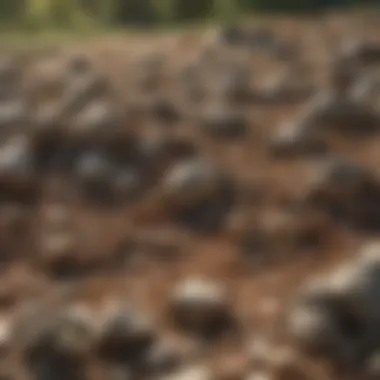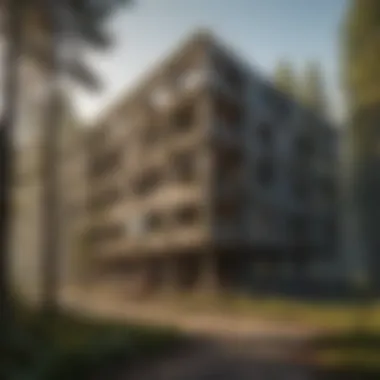The Asbestos Debate: Understanding Vermiculite Insulation


Intro
Vermiculite insulation has a complex history intertwined with concerns about asbestos exposure. As a material, vermiculite has been widely used in construction since the mid-20th century. However, its significance extends beyond just being a preferred insulation product. It raises serious questions about health risks associated with asbestos.
In this article, we will explore the historical usage of vermiculite insulation, focusing particularly on the significant concerns regarding its potential asbestos content. The analysis includes a review of scientific studies that have investigated the issue, as well as an overview of regulatory standards that govern its usage. We will delve into the implications for safety in homes and buildings, providing a nuanced understanding of why this topic is crucial for anyone involved in construction or interested in environmental safety.
The aim is to equip readers with the information necessary for informed decision-making when it comes to building materials, especially concerning those materials with potential health risks.
Understanding Vermiculite Insulation
Vermiculite insulation has gained attention due to its historical use and the concerns surrounding its potential asbestos content. Understanding this material is crucial for various reasons. First, vermiculite is used extensively in insulation, presenting both opportunities and risks for professionals in construction and renovation. Awareness of its composition and properties is essential for making informed decisions about safety and compliance.
Definition and Composition
Vermiculite is a naturally occurring mineral that expands when heated. The result is a lightweight, popcorn-like material that is further processed for various applications, including insulation. Its mineral composition mainly includes magnesium, aluminum, iron, and silicate. The expanded form of vermiculite is used effectively to insulate buildings and other structures, due to its excellent thermal resistance. While vermiculite itself is not inherently harmful, concerns arise regarding its sourcing. Some vermiculite mines have been found to co-locate with asbestos, raising red flags for its use in insulation materials produced in the past.
Properties and Benefits
The properties of vermiculite insulation make it a favored choice among builders for many years. It is non-combustible, meaning it does not support flame spread, which is a critical safety attribute. Additionally, it has excellent sound insulation qualities, making it beneficial for noise reduction in homes. The lightweight nature of vermiculite allows for easy handling and installation, reducing labor costs and time on-site. Moreover, it is inert, meaning it does not react with other materials, contributing to its durability and long lifespan. These characteristics are what initially led to its widespread adoption in construction.
Common Uses in Construction
Vermiculite is utilized in various settings within the construction industry. Common applications include:
- Insulation: Used in attics, walls, and floors to enhance thermal performance.
- Horticulture: Employed in potting mixes to improve aeration and moisture retention.
- Lightweight concrete: Incorporated into concrete mixes to reduce the overall weight while retaining strength.
- Fireproofing: Certain vermiculite products are employed as fireproofing materials for steel structures.
Each application demonstrates the versatility of vermiculite insulation, yet it is essential to remain aware of the potential asbestos issues tied to its historical use. By understanding the composition and properties of vermiculite, professionals can navigate the complexities associated with its application safely.
The Asbestos Connection
Understanding the relationship between vermiculite insulation and asbestos is vital for homeowners and industry professionals alike. This section examines the historical context of asbestos in building materials. It will also identify specific cases where vermiculite has been associated with asbestos and review scientific findings that contribute to this ongoing debate. The implications cannot be overstated; knowledge in this area can help mitigate health risks and inform decision-making regarding insulation choices.
History of Asbestos in Building Materials
Asbestos has been used for centuries in construction due to its exceptional heat resistance and insulating properties. In the early 20th century, the incorporation of asbestos into various building materials became common practice. This was especially true in products like insulation, roofing, and even flooring. The widespread use persisted until health implications became clear in the 1970s, when studies linked asbestos exposure to severe respiratory illnesses, including asbestosis and mesothelioma. The following facts are assocaited with its historical use:
- Versatility: Asbestos was used in multiple products for its durability.
- Widespread Popularity: It appeared in homes and public buildings extensively.
- Regulation Response: Increased awareness led to governmental regulations restricting its use.
Today, the ramifications of this history are still felt, especially for older buildings where asbestos may linger, hidden within materials such as vermiculite insulation.
Specific Instances of Asbestos in Vermiculite
Vermiculite insulation, particularly the product mined from Libby, Montana, has repeatedly been identified as a potential source of asbestos exposure. During the mining and processing of vermiculite, asbestos fibers could contaminate the final product. This became evident when health studies were conducted around the mines in Libby, revealing high levels of asbestos-related diseases among residents and workers.
The potential for asbestos in vermiculite was largely underreported until more recent investigations made the public aware. Some key points include:


- Libby, Montana: This location produced the most notorious vermiculite that contained asbestos.
- Contamination Risks: Even small amounts of asbestos can pose significant health risks.
- Consumer Awareness: Homeowners are often unaware of the potential dangers in their homes.
Scientific Research Findings
Numerous studies have focused on understanding the health implications of asbestos in vermiculite. Research has generally found a correlation between exposure to contaminated vermiculite and an increased risk of developing asbestos-related diseases. Some highlighted findings include:
- A heightened incidence of respiratory illness among those exposed to Libby vermiculite.
- Laboratory analyses detailing how asbestos fibers can be released into the air when vermiculite is disturbed.
"Scientific evidence shows a direct link between vermiculite insulation sourced from Libby and serious health issues. Understanding this connection is key to ensuring safety."
Research continues to evolve as more samples are tested and new data becomes available. This ongoing investigation is crucial for anyone involved in construction and home renovation to make informed choices.
In summary, the connection between asbestos and vermiculite insulation is a complex and critical topic. Understanding its history, identifying instances of contamination, and considering scientific research can provide essential insights for better decision-making in insulation choices. By doing so, the risks associated with asbestos exposure can be minimized.
Health Risks Associated with Asbestos Exposure
The discussion around health risks related to asbestos is critical when evaluating the implications of vermiculite insulation. Asbestos is known for its fibrous structure, which can become airborne when disturbed. This leads to inhalation, and the subsequent risks can be severe. Understanding the connection between vermiculite and asbestos helps to identify potential hazards in older buildings, where this insulation may still be present. A comprehensive grasp of these health risks is essential for making informed safety choices.
Types of Health Issues Linked to Asbestos
Asbestos exposure is associated with several serious health conditions, mainly affecting the lungs and respiratory system. Key health issues include:
- Asbestosis: A chronic lung disease caused by inhaling asbestos fibers. It leads to lung tissue scarring, causing difficulty in breathing and decreased lung capacity.
- Mesothelioma: A rare and aggressive cancer that affects the lining of the lungs, heart, or abdomen. It has a strong link to asbestos exposure.
- Lung Cancer: A significant risk factor for developing lung cancer is asbestos exposure. The combination of smoking and asbestos increases this risk even further.
- Pleural Diseases: Conditions that affect the pleura, which is the lining surrounding the lungs. This includes pleural thickening and effusion due to asbestos exposure.
Every type of disease linked to asbestos requires attentive awareness due to their long latency periods. Symptoms may not manifest until many years after the initial exposure.
Symptoms of Asbestos-Related Illnesses
Identifying the symptoms related to asbestos exposure can be challenging, as they often appear years later. Common symptoms include:
- Persistent Cough: A long-lasting cough that does not go away can indicate underlying issues.
- Shortness of Breath: Difficulty in catching one’s breath during normal activities may be a sign of lung complications.
- Chest Pain: Discomfort or pain in the chest may occur as diseases progress.
- Fatigue: A sense of tiredness or weakness can accompany many lung conditions.
- Weight Loss: Unexplained loss of weight can also indicate a serious health condition.
Asbestos-related ailments often progress silently, emphasizing the importance of regular health screenings for individuals with a history of exposure.
Regulatory Landscape and Safety Measures
The intersection of vermiculite insulation and asbestos necessitates a thorough understanding of the regulatory landscape surrounding these materials. Proper regulations are essential to mitigate health risks associated with exposure to hazardous substances. They serve to ensure that construction and renovation activities adhere to safety standards that protect both workers and homeowners. The management of vermiculite insulation involves not just the awareness of its potential asbestos content but also compliance with stringent safety measures and guidelines set by various governing bodies.
Government Regulations on Asbestos
Government regulations play a vital role in managing the risks posed by asbestos, particularly in materials such as vermiculite insulation. In the United States, the Environmental Protection Agency (EPA) imposes regulations that include specific bans and limitations on the use of asbestos. Furthermore, laws such as the Clean Air Act and the Asbestos Hazard Emergency Response Act outline required practices for handling asbestos in both residential and commercial environments.
Legislation varies across countries, but several key principles remain consistent:
- Asbestos Bans: Many jurisdictions have outright banned the use of asbestos in new construction.
- Assessment and Management Plans: Regulations often require buildings to assess existing asbestos and develop management plans to ensure that it does not pose a health risk.
- Disclosure Requirements: Sellers and landlords may need to disclose any known asbestos presence to potential buyers or tenants.
Compliance with these regulations is crucial for minimizing health risks and providing safe living environments. Understanding the specific local regulations is key for homeowners and industry professionals alike.


Recommendations for Homeowners
Homeowners living in older homes may discover vermiculite insulation that could contain asbestos. Knowledge of regulatory measures can empower them to take informed actions regarding potential health threats. Here are some practical recommendations:
- Do Not Disturb: If insulation is intact and undisturbed, generally, it is safest to leave it alone. Disturbing such materials can release asbestos fibers into the air.
- Professional Inspection: Homeowners should consider hiring qualified professionals to assess insulation. Testing can determine if asbestos is present and identify the type and condition of the material.
- Encapsulation: If asbestos is present but not in a condition that poses a risk, encapsulation methods can be used to seal the material, preventing fiber release.
- Removal by Professionals: If remediation is necessary, only certified asbestos removal experts should handle it. They follow strict regulations to safely dispose of hazardous materials.
In summary, navigating the regulatory landscape surrounding vermiculite insulation and asbestos requires awareness and action. By understanding government regulations and implementing proper measures, homeowners can safeguard their health and that of their families.
"Homeowners must be proactive about understanding the risks and regulations associated with vermiculite insulation to make informed decisions for their safety."
Testing for Asbestos in Vermiculite Insulation
Testing for asbestos in vermiculite insulation is a crucial aspect of ensuring safety in buildings. This section emphasizes the significance of identifying asbestos content in insulation, particularly in homes built before the 1990s. The historical use of vermiculite insulation, especially from the Libby mine in Montana, often included asbestos, which poses serious health risks.
Proper testing can help homeowners and builders mitigate these risks. Knowledge about the insulation's composition can inform decisions that affect current and future occupants. It is essential for maintaining health and safety standards in residential and commercial environments.
How to Identify Asbestos in Insulation
Identifying asbestos in vermiculite insulation requires careful observation and, often, professional evaluation. Here are some key steps:
- Visual Inspection: Vermiculite insulation typically appears as a light gray or brown, crumbly, and pearl-like material.
- Age of the Property: Homes built before the 1990s are more likely to contain asbestos in their insulation.
- Labeling and Documentation: Check any available construction documents for details about the insulation type installed.
- Samples for Testing: If there is a suspicion of asbestos, obtaining samples may be necessary. This process must be approached with caution to avoid releasing fibers into the air.
It is recommended to consult resources like the Environmental Protection Agency (EPA) for guidelines on managing and testing asbestos.
Professional Testing Services
Using professional testing services is strongly advised for accurate results regarding asbestos presence in vermiculite insulation. Professionals have the right equipment and expertise to carry out the following:
- Sampling: Technicians can safely take samples from the insulation without jeopardizing air quality or safety.
- Laboratory Analysis: Samples are sent to certified laboratories for thorough analysis. Various methods, such as polarized light microscopy (PLM), are used to determine asbestos presence.
- Interpretation of Results: Professionals can interpret results, leading to informed decisions on remediation or removal.
Engaging professional services not only ensures accuracy but also provides peace of mind and adherence to safety regulations.
Overall, ensuring safe conditions involves understanding the risks associated with vermiculite insulation and selecting the right approach to testing and analysis.
Alternatives to Vermiculite Insulation
The discussion about insulation in buildings increasingly now turns to alternatives to vermiculite. Given the historical connection between vermiculite and asbestos, homeowners, builders, and environmental professionals seek safer options. These alternatives should not just offer thermal efficiency but also assurance against potential health risks associated with asbestos exposure.
Alternative Insulation Materials
Consider a few common materials that serve as viable alternatives to vermiculite insulation:
- Fiberglass Insulation: Widely used, fiberglass consists of tiny glass fibers. It is non-combustible and resistant to moisture, making it suitable for a range of applications. Additionally, fiberglass is less expensive compared to some alternatives.
- Cellulose Insulation: Made from recycled paper products, cellulose insulation is eco-friendly. It often contains a fire retardant and is treated to resist pests, creating a sustainable choice in insulation.
- Spray Foam Insulation: This polyurethane option expands on application, filling gaps and cracks. Spray foam provides excellent air sealing properties and has a high R-value, ensuring effective thermal performance.
- Mineral Wool (Rock Wool) Insulation: Known for its fire-resistant properties, mineral wool is made from natural or recycled materials. It also offers soundproofing benefits and is resistant to moisture and pests.
Exploring these options is key for improving the safety and comfort of buildings, especially considering the potential health concerns linked to vermiculite insulation.
Benefits of Safer Options


Opting for alternatives to vermiculite insulation has several benefits:
- Enhanced Safety: Non-asbestos insulation materials fundamentally reduce the risk of asbestos-related health issues. This addresses public concern about long-term exposure to hazardous materials.
- Improved Energy Efficiency: Many alternatives, such as spray foam and cellulose, can outperform vermiculite in terms of thermal insulation. This translates to lower energy costs and better temperature regulation within homes.
- Environmental Considerations: Materials like cellulose are eco-friendly, utilizing recycled content. Choosing sustainable options supports broader environmental goals and promotes responsible building practices.
- Fire Resistance: Insulation materials such as mineral wool offer enhanced fire protection. This characteristic adds a layer of safety for homeowners and their properties.
"Choosing insulation materials carefully ensures both the comfort of a home and the health of its occupants."
In summary, the selection of alternative insulation materials is crucial in the broader context of health and safety in construction. As knowledge about the potential risks of vermiculite insulation spreads, it pushes formerly accepted norms and encourages innovative solutions in building practices.
Case Studies and Real-World Implications
Understanding case studies surrounding vermiculite insulation and asbestos exposure is crucial for grasping the broader implications of this issue. These incidents often reveal the complex interplay between building materials and health risks, showcasing how the presence of asbestos in vermiculite can drastically impact communities. By examining specific cases, we can assess not only the immediate consequences of exposure but also the long-term effects on public health policies and safety regulations.
Notable Incidents of Asbestos Exposure
Several documented instances of asbestos exposure linked to vermiculite insulation provide valuable lessons. One prominent case is the Libby, Montana, scenario. The W.R. Grace Company operated a vermiculite mine there, which was later found to contain high levels of asbestos. Residents and workers were exposed for decades, resulting in a significant number of illnesses and deaths related to asbestos. This incident highlighted the importance of proper regulation and the dangers of unmonitored exposure.
Another notable case is in the town of Elmira, New York, where vermiculite insulation was widely used in older homes. Studies identified clusters of asbestos-related diseases in the area. This prompted state and local health officials to take action, leading to increased awareness and calls for residential inspections and remediation efforts.
These cases emphasize the need for responsible management of vermiculite insulation and appropriate preventive measures to protect the public from potential hazards.
Community Responses and Actions Taken
In response to these distressing situations, communities have mobilized to safeguard their health and environment. Following the revelations about the Libby mine, residents initiated a series of actions including:
- Advocacy Efforts: Community members formed advocacy groups pushing for cleanup and medical assistance for those affected.
- Legal Action: Legal proceedings against W.R. Grace and other related entities were pursued to seek accountability and compensation for victims.
In Elmira, public health campaigns were launched to educate residents about the dangers of asbestos exposure.
- Inspection Programs: Local governments instituted mandatory inspections of homes with vermiculite insulation. This helped identify properties at risk and guided homeowners about necessary remediation steps.
- Resource Allocation: Government agencies expanded funding for health programs aimed at monitoring and supporting exposed individuals.
These community responses illustrate the determination of individuals to confront the dangers posed by vermiculite insulation. They emphasize a collective understanding of the need for awareness and action against such public health threats.
"The history of asbestos in our homes is a reminder of the profound impact of industrial practices on community health."
Finale and Future Considerations
Understanding the connection between vermiculite insulation and asbestos is crucial for homeowners, builders, and environmental professionals alike. This topic not only informs safety practices but also guides informed decision-making regarding building materials. The implications of asbestos exposure extend beyond individual health; they reflect upon community well-being and regulatory frameworks.
Summary of Key Points
In this article, we reviewed various aspects of vermiculite insulation and its historical association with asbestos. Key points include:
- Definition and Composition: Vermiculite insulation is a mineral product, used widely for its excellent insulating properties.
- Asbestos Link: Historical usage revealed instances of asbestos contamination in vermiculite sourced from certain mines.
- Health Risks: Prolonged exposure to asbestos can lead to severe health issues, necessitating close attention to material safety.
- Regulatory Standards: Various regulations govern the use of asbestos in building materials, aimed at minimizing health risks.
- Testing and Alternatives: Vigilance in testing for asbestos and exploring safer insulation alternatives emerged as necessary steps for mitigation.
Future Research Directions
Future research should focus on several areas:
- Longitudinal Health Studies: Conduct more comprehensive studies on the long-term health effects of exposures within different demographics.
- Material Testing Protocols: Develop standardized methods for testing vermiculite insulation across varied environments and conditions to enhance reliability.
- Safer Alternatives Development: Investigate new insulation materials that offer similar or improved properties without the risks associated with asbestos.
- Public Education Campaigns: Increase awareness and understanding of the risks associated with vermiculite insulation through educational initiatives.
"As we advance, it is essential to bridge the gap between scientific research and implementation of safety measures in construction practices."
The future landscape of building materials is poised for change; understanding vermiculite insulation's role and its potential hazards remains an essential inquiry in our collective journey toward safer living environments.















